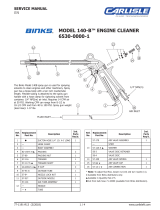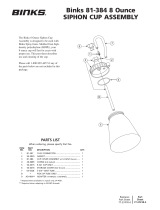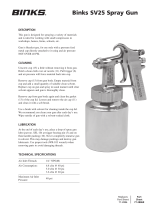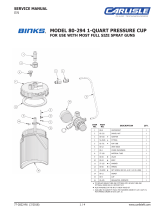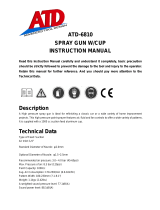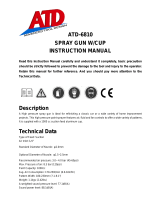Page is loading ...

77-2625-R14 (4/2018) 1 / 12 www.carlisleft.com
Model 95 Signature Series
Spray Gun
This handheld gun is the premier spray
gun in the Binks line. A combination
of the three best industrial spray guns,
Model 95 sets a new standard.
The
Model 95 is a high production
gun with stainless steel fluid passages
which may be used with most coatings.
This new gun replaces Models 18, 62
and BBR spray guns, incorporating
the best features of all three: drop-
forged anodized alumninum body,
stainless steel fluid passages,
adjustable floating needle valve,
stainless steel or tungsten carbide
fluid nozzle, plated drop-forged
brass self-centering air nozzle, brass
air valve cartridge, adjustable spray
pattern, 3/8” NPS(m) fluid inlet, 1/4”
NPS(m) air inlet. Weight 1 lb., 11 oz.
Illustration Key
1. Air Nozzle Assembly
2. Gun Body
3. Side Port Controls
4. Fluid Control Knob
5. Air Connection 1/4” NPS(m)
6. Fluid Connection 3/8” NPS(m)
1
3
2
4
5
6
PRESSURE FEED TANK HOOKUP
For medium production spraying (sin gle
regulator).
Air pressure for atomi zation is regulated
at extractor, fluid pressure at tank regulator
(see figure 3).
PRESSURE FEED TANK HOOKUP
For portable painting operations
(double regulator).
Air pressure for atomization and fluid
supply is regulated by two individual air
regulators on tank (see figure 4).
TYPES OF INSTALLATION
SIPHON FEED CUP HOOKUP
Air pressure for atomization is regulated at
extractor. The amount of fluid is adjusted
by fluid control screw on gun, viscosity of
paint, and air pressure (see figure 1).
PRESSURE FEED CUP HOOKUP
For fine finishing with limited spraying.
Air pressure for atomization is regulated at
extractor; fluid pressure at cup regulator. For
heavy fluids and internal mix nozzle spray-
ing, fluid adjusted by control screw on gun.
Pressure cup also available less regulator
(see figure 2).
Extractor
Figure 1
Air
Siphon Cup
Extractor
Figure 5
Air
Fluid
Fluid
Regulator
Fluid
Figure 4
Air
Supply
Air Supply
Pressure
Tank
Extractor
Air
Inlet
Figure 3
Air
Fluid
Outlet
Pressure
Tank
Fluid
Oil & Water
Extractor
Cup
Regulator
Figure 2
Air
Fluid
Pressure Cup
PRESSURE FEED CIRCULATING
HOOKUP
For heavy production spraying.
Air pressure atomization regulated at
extractor. Fluid pressure regulated at fluid
regulator (see figure 5).
EN
SERVICE MANUAL
MODEL 95 SPRAY GUN
6121-XXXX-X

EN
77-2625-R14 (4/2018)2 / 12www.carlisleft.com
LOCK OUT / TAG-OUT
Failure to de-energize, disconnect, lock out and tag-out all power
sources before performing equipment maintenance could cause
serious injury or death.
OPERATOR TRAINING
All personnel must be trained before operating finishing
equipment.
EQUIPMENT MISUSE HAZARD
Equipment misuse can cause the equipment to rupture,
malfunction, or start unexpectedly and result in serious injury.
PROJECTILE HAZARD
You may be injured by venting liquids or gases that are released
under pressure, or flying debris.
PINCH POINT HAZARD
Moving parts can crush and cut. Pinch points are basically any
areas where there are moving parts.
INSPECT THE EQUIPMENT DAILY
Inspect the equipment for worn or broken parts on a daily basis.
Do not operate the equipment if you are uncertain about its
condition.
In this part sheet, the words WARNING, CAUTION and NOTE are used to
emphasize important safety information as follows:
Hazards or unsafe practices which
could result in minor personal injury,
product or property damage.
!
CAUTION
Hazards or unsafe practices which
could result in severe personal
injury, death or substantial property
damage.
!
WARNING
Important installation, operation or
maintenance information.
NOTE
Read the following warnings before using this equipment.
READ THE MANUAL
Before operating finishing equipment, read and understand all
safety, operation and maintenance information provided in the
operation manual.
WEAR SAFETY GLASSES
Failure to wear safety glasses with side shields could result in
serious eye injury or blindness.
NEVER MODIFY THE EQUIPMENT
Do not modify the equipment unless the manufacturer provides
written approval.
IT IS THE RESPONSIBILITY OF THE EMPLOYER TO PROVIDE THIS INFORMATION TO THE OPERATOR OF THE EQUIPMENT.
FOR FURTHER SAFETY INFORMATION REGARDING THIS EQUIPMENT, SEE THE GENERAL EQUIPMENT SAFETY BOOKLET (77-5300).
KNOW WHERE AND HOW TO SHUT OFF THE EQUIPMENT
IN CASE OF AN EMERGENCY
PRESSURE RELIEF PROCEDURE
Always follow the pressure relief procedure in the equipment
instruction manual.
NOISE HAZARD
You may be injured by loud noise. Hearing protection may be
required when using this equipment.
STATIC CHARGE
Fluid may develop a static charge that must be dissipated through
proper grounding of the equipment, objects to be sprayed and all
other electrically conductive objects in the dispensing area. Improper
grounding or sparks can cause a hazardous condition and result in
fire, explosion or electric shock and other serious injury.
PROP 65 WARNING
WARNING: This product contains chemicals known to the
State of California to cause cancer and birth defects or other
reproductive harm.
WEAR RESPIRATOR
Toxic fumes can cause serious injury or death if inhaled.
Wear a respirator as recommended by the fluid and solvent
manufacturer’s Safety Data Sheet.
TOXIC FLUID & FUMES
Hazardous fluid or toxic fumes can cause serious injury or death if
splashed in the eyes or on the skin, inhaled, injected or
swallowed. LEARN and KNOW the specific hazards or the fluids
you are using.
KEEP EQUIPMENT GUARDS IN PLACE
Do not operate the equipment if the safety devices have been
removed.
!
WARNING
AUTOMATIC EQUIPMENT
Automatic equipment may start suddenly without warning.
FIRE AND EXPLOSION HAZARD
Improper equipment grounding, poor ventilation, open flame or
sparks can cause a hazardous condition and result in fire or
explosion and serious injury.
MEDICAL ALERT
Any injury caused by high pressure liquid can be serious. If you
are injured or even suspect an injury:
• Go to an emergency room immediately.
• Tell the doctor you suspect an injection injury.
• Show the doctor this medical information or the medical alert
card provided with your airless spray equipment.
• Tell the doctor what kind of fluid you were spraying or
dispensing.
GET IMMEDIATE MEDICAL ATTENTION
To prevent contact with the fluid, please note the following:
• Never point the gun/valve at anyone or any part of the body.
• Never put hand or fingers over the spray tip.
• Never attempt to stop or deflect fluid leaks with your hand,
body, glove or rag.
• Always have the tip guard on the spray gun before spraying.
• Always ensure that the gun trigger safety operates before
spraying.

EN
77-2625-R14 (4/2018) 3 / 12 www.carlisleft.com
The first requirement for a good resultant finish is
the proper handling of the gun. The gun should be
held perpendicular to the surface being covered and
moved parallel with it. The stroke should be started
before the trigger is pulled and the trigger should
be released before the stroke is ended. This gives
accurate control of the gun and material.
The distance between gun and surface should be 6
to 12 inches depending on material and atomizing
pressure. The material deposited should always be
even and wet. Lap each stroke over the preceding
stroke to obtain a uniform finish.
NOTE
To reduce overspray and obtain maximum efficiency, always
spray with the lowest possible atomizing air pressure.
Coating should be even
and wet when spraying
Start
stroke
Pull
trigger
Release
trigger
End of
stroke
RIGHT
TRAVEL OF GUN
6 to 12 inches
Coating will
be light at
this point
Coating will
be heavy
at this point
WRONG
AIR PRESSURE
GUN HANDLING
BINKS OIL AND WATER EXTRACTOR IS IMPORTANT
Only 34 PSI at gun inlet
25 feet of 1/4” I.D. hose causes a drop of
26 PSI between the air supply and the gun.
(NOT RECOMMENDED)
48 PSI at gun inlet
25 feet of 5/16” I.D. hose causes a drop of
12 PSI between the air supply and the gun.
For this reason Binks recommends the use
of 5/16” hose.
(RECOMMENDED)
Atomizing pressure must be set properly to allow for the drop
in air pressure between the regulator and the spray gun.
Achieving a fine spray finish without the use of a
good oil and water extractor is virtually impossible.
A Binks regulator / extractor serves a double pur-
pose. It eliminates blistering and spotting by keep-
ing air free of oil and water, and it gives precise air
pressure control at the gun.
Binks recommends using Model HFRL-508 Oil and
Water Extractor / Regulator. See your local distributor
for other models.
5/16”
1/4”
With 60 psi applied at air supply
Cross section view
showing comparison of inside
hose diameters (actual size).
60 lbs. regulated pressure
It is extremely poor practice to mount the oil and
water extractor on or even near the compressor
unit. The temperature of the air is greatly increased
as it passes through the compressor and this com-
pressed air must be cooled before the moisture in
it will condense. If the air from the compressor is
still warm when it passes through the oil and water
extractor, moisture will not be effectively removed,
but will remain in suspension. Then, when the air
cools in the hose beyond the extractor, the moisture
will condense into drops of water and cause trouble.
Air lines must be properly drained
Pitch all air lines back towards the compressor so
that condensed moisture will flow back into the
air receiver where it can be removed by opening a
drain. Every low point on an air line acts as a water
trap. Such points should be fitted with an easily
accessible drain. See diagram.
AIR SUPPLY

EN
77-2625-R14 (4/2018)4 / 12www.carlisleft.com
In normal operation, the wings on
the nozzle are horizontal as illus-
trated here. This provides
a vertical fan shaped pattern which
gives maxi-
mum coverage
as the gun is
moved back
and forth
parallel to the
surface being
finished.
Spray width adjustment: Turn clock-
wise for round, counterclockwise for fan.
Fluid control screw: Turn clockwise
to decrease flow, counterclockwise to
increase flow.
As width of spray is increased, more
material must be allowed to pass through
the gun to obtain the same coverage on
the increased area.
SIPHON SPRAYING
Set atomization pressure at approxi-
mately 50 PSI for lacquer and 60 PSI for
enamel. Test spray. If the spray is too
fine, reduce the air pressure or open fluid
control screw. If the spray is too coarse,
close the fluid control screw. Adjust the
pattern width and repeat adjustment of
spray if necessary.
PRESSURE SPRAYING
After selecting correct size fluid orifice,
set fluid pressure for desired flow. Open
atomization air and test spray. If spray is
too fine, reduce air pressure. If spray is
too coarse, raise air pressure. Adjust pat-
tern width and repeat adjustment of spray.
Keeping fluid control screw in open posi-
tion will reduce fluid needle wear.
The spray pattern of
the Binks gun is variable
from round to flat with
all patterns in between.
Spray width
adjustment
Fluid
control
screw
FAULTY PATTERNS AND HOW TO CORRECT THEM
PATTERN CAUSE CORRECTION
Dried material around the
outside of the fluid nozzle tip
at position “C” restricts the
passage of atomizing air at
one point through the center
opening of air nozzle and
results in pattern shown.
This pattern can also be caused
by a loose air nozzle.
Dried material in side-port
“A” restricts passage of air.
Greater flow of air from
cleaner side-port “B” forces
fan pattern in direction of
clogged side.
Dissolve material in side-ports with thin-
ner,
then blow gun clean. Do not poke into
openings with metal instruments.
Remove air nozzle and wipe off fluid tip
using rag wet with thinner. Tighten air
nozzle.
A split spray or one that is heavy on each
end of a fan pattern and weak in the mid-
dle is usually caused by:
(1) Too high an atomization air pressure
(2) Attempting to get too wide a spray pat-
tern with thin material.
Reducing air pressure will correct cause (1).
To correct cause (2), open material control
to full position by turning to left. At the
same time, turn spray width adjustment to
right. This will reduce width of spray, but
will correct split spray pattern.
(1) Dried out packing around material nee-
dle valve permits air to get into fluid
passageway. This results in spitting.
(2) Dirt between fluid nozzle seat and
body or loosely installed fluid nozzle
will make gun spit.
(3) A loose or defective swivel nut on
siphon cup or material hose can cause
spitting.
To correct cause (1) back
up knurled nut (E), place
two drops of machine oil
on packing, replace nut
and tighten with fingers
only. In aggravated cases,
replace packing.
To correct cause (2), remove fluid nozzle (F),
clean back of nozzle and nozzle seat in gun
body using rag wet with thinner, replace
nozzle and draw up tightly against body.
To correct cause (3), tighten or replace
swivel nut.
E
F
G

EN
77-2625-R14 (4/2018) 5 / 12 www.carlisleft.com
SPRAY GUN CLEANING INSTRUCTIONS
MAINTENANCE
In certain states it is now against the law
to spray solvents containing Volatile
Organic Compounds (VOC)’s into the
atmosphere when cleaning a spray gun.
In order to comply with these air quality
laws Binks recommends one of the fol-
lowing two methods to clean your spray
finishing equipment:
1. Spray solvent through the gun into a
closed system. An enclosed unit or
spray gun cleaning station condenses
solvent vapors back into liquid form
which prevents escape of VOC’s into
the atmosphere.
2. Place spray gun in a washer type
cleaner. This system must totally
enclose the spray gun, cups, nozzles
and other parts during washing, rins-
ing and draining cycles. This type
of unit must be able to flush solvent
through the gun without releasing any
VOC vapors into the atmosphere.
Additionally, open containers for storage
or disposal of solvent or solvent-contain-
ing cloth or paper used for surface prepa-
ration and clean-up may not be used.
Containers shall be nonabsorbent.
AIR AND FLUID NOZZLE
CLEANING
A faulty spray pattern is often caused by
improper cleaning resulting in dried
materials around the material nozzle tip
or in the air nozzle. Soak these parts in
thinners to soften the dried material and
remove with a brush or cloth.
If either the air nozzle or fluid nozzle are
damaged, these parts must be replaced
before perfect spray can be obtained.
CLEANING GUN USED WITH
1 QUART CUP
Relieve pressure in the cup. Then,
unscrew, empty and carefully rinse cup
out with thinners. Place clean thinners in
the cup and spray this through the gun
until it is clean. Blow air through gun
to dry it.
CLEANING GUN USED WITH
PRESSURE CONTAINER
Hold a piece of cloth wadded in the hand
over the gun nozzle and pull the trigger.
The air will back up through the material
nozzle and force the material out of the
hose into the container. Empty container.
Put enough thinners into the container to
wash the hose and gun thoroughly and
spray this through the gun until it is clean.
Then blow out the material hose to dry
it and remove all traces of material by
attaching it to the air line.
CLEANING GUN USED WITH
PAINT CIRCULATING SYSTEM
Shut off material supply and remove
material hose from gun. Clean gun as
used with siphon cup or pressure contain-
er or connect quick release on paint line
solvent line. To ensure clean air to spray
gun, use Binks oil and water extractor.
See your Binks distributor for the correct
model.
TO REPLACE AIR VALVE AND
SPINDLE ASSEMBLY
Remove material valve control knob (21),
spring (18), and needle assembly (20).
Unscrew housing (19), and remove spin-
dle assembly (17) with springs (16 & 18),
housings (15), and o-rings (14). Lubricate
new o-rings with Gunners Mate.
Assemble components using material
needle. Place this assembly along with
housing (19) into gun body and screw
into position. Remove material needle
(20) and tighten housing (19).
TO REPLACE NEEDLE SEAL
AND GLAND ADAPTER IN
FLUID INLET
Remove material valve control knob
(21) and spring (18) and pull out
fluid needle (20). Unscrew packing nut
(30) and remove spring (29) and seal
backup (28). Using a no. 10 x 1-1/4”
coarse-thread wood screw (Binks Part
No. 20-6536) or small sheet metal screw,
remove the needle seal (27) and gland
adapter (26). Replace gland adapter (26)
and needle seal (27). Re-insert seal back-
up (28) spring (29) and screw on packing
nut (30) a couple of turns so it fits loosely
by hand. Reassemble fluid needle (20),
spring (18) and material valve control
knob (21). Finally, tighten packing
nut (30) until it bottoms out on fluid
inlet (25).
LUBRICATION
Lubricate daily, all moving parts includ-
ing trigger pivot point and air valve spin-
dle and with Binks Gunners Mate (44).
WARNING
Injection of material from the gun
into the skin may result in serious
personal injury. Shut off the air
supply to the container and release
the pressure on the container before
attempting to clean the gun.
!
CAUTION
Never use metal instruments to
clean the air or material nozzles.
These parts are carefully machined
and any damage to them will cause
faulty spray.
!

EN
77-2625-R14 (4/2018)6 / 12www.carlisleft.com
43
46
42
44
1
2
3
4
5
6
7
14
15
16
17
18
15
14
19
20
21
18
9
10
11
12
13
8
24
23
22
31
30
29
28
27
26
2545
Binks Model 95 SPRAY GUN
47
48
49
50
Optional for vitreous
applications,
order Fluid Inlet
Assembly Kit 54-4511.
51

EN
77-2625-R14 (4/2018) 7 / 12 www.carlisleft.com
ITEM PART
NO. NO. DESCRIPTION QTY.
1 * AIR CAP ASSEMBLY .............................. 1
2 * FLUID NOZZLE (Stainless Only) ............... 1
3 54-918
•
m
^ SEALING RING ....................................... 1
4 54-4215 HEAD INSERT ........................................ 1
5 — 95 SERIES GUN HANDLE ...................... 1
6 54-3580 TRIGGER STUD ...................................... 1
7 54-3581 TRIGGER SCREW ................................... 1
8 54-4216 SIDE PORT CONTROL ASSEMBLY ........ 1
9 54-4219 CONTROL STEM .................................... –
10 54-3511
m
RETAINING RING .................................. –
11 54-4218 CONTROL BODY ................................... –
12 20-6160
ml
O-RING .................................................. –
13 54-4217 CONTROL SCREW ................................. –
14 20-4615
ml
^ O-RING .................................................. 2
15 54-3515 HOUSING .............................................. 2
16 54-3520
ml
SPRING (Yellow) ..................................... 1
17 54-3512
ml
SPINDLE ASSEMBLY .............................. 1
18 54-3518
ml
SPRING (Blue – 6 lbs., 8 oz.) ..................... 2
19 54-3541 HOUSING .............................................. 1
20 * FLUID NEEDLE (Stainless Only) ............... 1
21 54-3606 MATERIAL VALVE CONTROL KNOB .... 1
22 54-768 AIR CONNECTION ................................. 1
ITEM PART
NO. NO. DESCRIPTION QTY.
23 54-3504 PLUG ..................................................... 1
24 54-3578 TRIGGER ................................................ 1
25 54-4210 FLUID INLET .......................................... 1
26 54-4264
•
m
GLAND ADAPTER ................................. –
27 54-4265
•
m
NEEDLE SEAL ........................................ –
28 54-4266
•
m
SEAL BACKUP ....................................... –
29 54-4267
•
m
SPRING .................................................. –
30 54-4263
•
m
PACKING NUT ....................................... –
31 54-3513 VALVE SPINDLE CAP ............................ 1
43 82-469 GUN BRUSH .......................................... 1
44 — GUNNERS MATE (3cc) ........................... 1
45 54-3592
•
m
COPPER GASKET ................................... 1
OPTIONAL ACCESSORIES (Please order separately)
42 54-4213 WRENCH (Optional) ............................... 1
46 OMX-88 GUN BRUSH (Optional) .......................... 1
— 6-429 GUNNERS MATE (20 ea. 2 oz. bottles) ..... 1
OPTIONAL SPRINGS (Please order separately)
18 54-4427 HEAVY DUTY SPRING (29 lbs.) .............. 1
PARTS LIST
(When ordering, please specify Part No.)
FOR VITREOUS APPLICATIONS – PLEASE ORDER SEPARATELY
SEE PAGE 8 FOR OPTIONAL NOZZLE SETUPS
ITEM PART
NO. NO. DESCRIPTION QTY.
49 54-4531
s
•
m
PACKING SPACER ................................. 1
50 54-4542
s
NUT ASSEMBLY .................................... 1
51 54-4511
s
FLUID INLET ASSEMBLY (VITREOUS) ... 1
* See Air Cap, Fluid Nozzle, and Needle Selection Chart page 8.
m Part of Repair Kit 54-3577 (Fluid Inlet and Air Valve Kit). Available only as a part of its assembly.
• Part of Repair Kit 54-4225 (Fluid Inlet Packing Kit).
l Part of Repair Kit 54-4226 (Air Valve Spindle Kit).
^ Part available separately in package of 5 (add -5 to part number).
ITEM PART
NO. NO. DESCRIPTION QTY.
47 54-4568
s
FLUID INLET .................................. 1
48 20-2227-5
s
•
m ✝
O-RING .......................................... 1
s
Part of Fluid Inlet Assembly Kit 54-4511 (optional for vitreous applications). • Part of Repair Kit 54-4225 (Fluid Inlet Packing Kit).
m Part of Repair Kit 54-3577 (Fluid Inlet and Air Valve Kit). Available only as a part of its assembly.
✝
Part available separately in package of 5.

EN
77-2625-R14 (4/2018)8 / 12www.carlisleft.com
NOZZLE and NEEDLE SELECTION CHARTS
VERY THIN 63ss x 63P PE 4.5 7.5 10.0 5 663 47-66300
14-16 secs. Zahn 2 Cup 63Bss x 63PB PE 9.0 14.3 20.0 14 663A 47-66310
Wash primers, dyes, 66ss x 66SD SE 7.9 12.1 — 10.5 665 47-66500
stains, solvents, 66ss x 66SK SE 11.0 15.2 19.5 13 665 47-66500
water, inks 63Bss x 200 PI 3.1 5.2 6.4 12 663A 47-66310
THIN 63Ass x 63P PE 5.1 8.37 12.2 11 663A 47-66310
16-20 secs. Zahn 2 Cup 66ss x 66SK SE 11.0 15.2 19.5 13 665 47-66500
Sealer, lacquers, primers, 63Bss x 200 PI 3.1 5.2 6.4 12 663A 47-66310
inks, lubricants,
zinc chromates, acrylics
MEDIUM 63Bss x 63PB PE 9.0 14.3 20.0 14 663A 47-66310
19-30 secs. Zahn 2 Cup 66ss x 66SD SE 7.9 12.1 — 11 665 47-66500
Synthetic enamels, varnishes, 66ss x 66SK SE 11.0 15.2 19.5 13 665 47-66500
shellacs, fillers, primers, 63Css x 200 PI 3.1 5.2 6.4 12 663A 47-66310
epoxies, urethanes, lubricants,
wax emulsions, enamels
HEAVY 67ss x 67PB PE 9.5 14.9 19.5 12 667 47-66700
(Cream-like) 68ss x 68PB PE 9.5 14.1 19.1 12 668 47-66800
Over 28 secs. No. 4 Ford Cup 67ss x 206 PI 6.0 9.5 13.0 15 667 47-66700
VERY HEAVY 68ss x 68PB PE 9.5 14.1 19.1 12 668 47-66800
Texture coatings, 68ss x 206 PI 6.2 9.8 13.2 15 668 47-66800
Road marking paint 59Ass x 244 PI 7.8 11.5 15.2 12 659 47-65900
59Ass x 245 PI 7.8 11.5 15.2 6 659 47-65900
59Bss x 251 PI 7.8 11.5 15.2 12 659 47-65900
59Bss x 252 PI 7.8 11.5 15.2 6 659 47-65900
59Css x 262 PI 7.3 11.0 14.7 6 659 47-65900
68ss x 206 PI 6.2 9.8 13.2 15 668 47-66800
ADHESIVES 63Bss x 66SD-3 PE 7.9 12.1 16.2 4 663 47-66300
Waterbase white vinyl glues 67ss x 67PB PE 9.5 14.1 19.1 12 667 47-66700
Solvent base, neoprenes 66ss x 66SD-3 PE 7.9 12.1 16.2 10 665 47-66500
(contact cement) 66ss x 66SDJG PE 10.4 — — 8-9 665 47-66500
66ss x 66R PE/SE — 4.2 — RD 665 47-66500
L6SS x 66SD-3 PE 9.5 14.2 19.0 10 665
47-66500
L3BSS x 66SD-3 PE 9.5 14.2 19.0 10 663A
47-66310
CERAMICS 67VT x 67PD PE 10.0 15.0 20.0 15 667VT 47-66702
Similar abrasive materials, 68VT x 68PB PE 9.5 14.1 19.1 12 668VT 47-66802
glazes, engobes,
porcelain enamel
BUFFING COMPOUNDS 64VT x 64PA PE 12.1 15.0 21.0 13 664VT (OBS) 47-66402 (OBS)
67VT x 67PD PE 10.0 15.0 20.0 15 667VT 47-66702
CONCRETE CURING 66ss x 200 PI 3.1 5.2 6.4 15 665 47-66500
COMPOUNDS
67ss x 206 PI 6.0 9.5 13.0 18 667 47-66700
68ss x 206 PI 6.2 9.8 13.2 20 668 47-66800
MULTICOLOR PAINTS 66ss x 200 PI 3.1 5.2 — 12 665 47-66500
67ss x 206 PI 6.0 9.5 — 15 667 47-66700
66ss x R3 PI — 4.2 — FAN 665 47-66500
66ss x R8 PI — 4.2 — FAN 665 47-66500
PTFE 63Ass x 63PB PE 9.0 14.3 20.1 10 663A 47-66310
66ss x 66SD PE 7.9 12.1 — 7 665 47-66500
HAMMERS 63ss X 63PB PE 9.0 14.3 — 14 663A 47-66310
66ss X 63PB PE 9.0 14.3 — 14 665 47-66500
66ss X 66SD PE 7.9 12.1 — 7 665 47-66500
WRINKLE ENAMELS 63Css x 63PB PE 9.0 14.3 20.0 10 663A 47-66310
66ss x 63PB PE 9.0 14.3 20.0 10 665 47-66500
ZINC RICH COATINGS 66ss x 67PD PE 12.0 18.0 24.0 15 665N (OBS) 47-66501 (OBS)
67VT x 67PB PE 9.5 14.1 19.1 12 667VT 47-66702
Note: PE - Pressure External SP - Siphon External PI - Pressure Internal
TYPE OF FLUID FLUID NOZZLE CFM AT MAX FLUID NEEDLE NOS. FLUID NEEDLE
TO BE SPRAYED X AIR TYPE 30 50 70 PATTERN FOR SPRAY GUN PART NO.
NOZZLES PSI PSI PSI AT 8” MODEL 95 MODEL 95
PART No. 45-5911 45-5912 45-5913 45-6301 45-6311 45-6321 45-6331 45-6501 45-6601 45-6701 45-6801
Nozzle No. 59ASS 59BSS 59CSS 63SS 63ASS 63BSS 63CSS 65SS 66SS 67SS 68SS
Orifice Size (in.) .171 .218 .281 .028 .040 .046 .052 .059 .070 .086 .110
Orifice Size (mm) 4.3 5.5 7.1 0.8 1.1 1.2 1.3 1.6 1.8 2.2 2.8

EN
77-2625-R14 (4/2018) 9 / 12 www.carlisleft.com
SPECIAL NOZZLES – INTERNAL MIX HEAVY MATERIAL
SEE CHART AIR & FLUID NOZLES
SPECIAL NOZZLE – CLEANING
FLUID
NOZZLE
#659 NEEDLE
ASSEMBLY
GUIDE
AIR NOZZLE
#54-2065
RING
#54-1584 RING
(USED WITH 200 SERIES
TIPS ONLY)
NOZZLE TIP:
200 SERIES,
NITRALLOY
#54-1583
BASE
SCREW
#54-928 10” CLEANING ATTACHMENT
(REQUIRED FOR DEGREASING AND LUBRICATING)
AIR CAP NOZZLE TYPE PART NO. CFM @ 30 PSI CFM @ 50 PSI CFM @ 70 PSI
MAX. PATTERN
WIDTH @ 8"
63PR PE 46-6079 9.5 15.5 19.5 18"
64PA PE 46-6007 12.1 15.0 21.0 13"
66PE PE 46-6014 15.0 13"
66PH PE 46-6016 11.5 16.4 22.0 13"
66R PE 46-6041 5.0 CFM @ 50 PSI Round Spatter
66S SE 46-6018 3.4 5.0 — 9"
66SD SE 46-6020 7.9 12.1 — 7–12"
66SD-3 SE 46-6092 10.4 15.4 20.4 9"
66SDJG PE 46-6103 10.4 8–9"
66SK SE 46-6082 11.0 15.2 19.5 13"
67PB PE 46-6026 9.5 14.9 19.5 12"
67PD PE 46-6028 10.0 15.0 20.0 15"
68PB PE 46-6032 9.5 14.1 19.1 12"
AIR CAP CHART
#54-4512
BASE & RING KIT
AIR CAP NOZZLE TYPE PART NO. ADDITIONAL REQUIRED PARTS
MAX CFM
@ 70 PSI
MAX. PATTERN
WIDTH
200
PI
46-2200
54-4512 BASE & RING
6.4 12"
201 46-2201 9.1 11"
206 46-2206 13 15"
242 46-2242 8.2
RD244 46-2244 15.2
250 46-2250 14.7
252 46-2252 15.2
6"
262 46-2262 14.7
SPECIALTY 200 SERIES INTERNAL MIX AIR CAPS

EN
77-2625-R14 (4/2018)10 / 12www.carlisleft.com
NOTES

EN
77-2625-R14 (4/2018) 11 / 12 www.carlisleft.com
NOTES

EN
77-2625-R14 (4/2018)12 / 12www.carlisleft.com
WARRANTY POLICY
This product is covered by Carlisle Fluid Technologies’ materials and workmanship limited warranty.
The use of any parts or accessories, from a source other than Carlisle Fluid Technologies,
will void all warranties. Failure to reasonably follow any maintenance guidance provided
may invalidate any warranty.
For specic warranty information please contact Carlisle Fluid Technologies.
For technical assistance or to locate an authorized distributor,
contact one of our international sales and customer support locations.
Region Industrial/Automotive Automotive Renishing
Americas
Tel: 1-800-992-4657 Tel: 1-800-445-3988
Fax: 1-888-246-5732 Fax: 1-800-445-6643
Europe, Africa,
Middle East, India
Tel: +44 (0)1202 571 111
Fax: +44 (0)1202 573 488
China
Tel: +8621-3373 0108
Fax: +8621-3373 0308
Japan
Tel: +81 45 785 6421
Fax: +81 45 785 6517
Australia
Tel: +61 (0) 2 8525 7555
Fax: +61 (0) 2 8525 7575
Carlisle Fluid Technologies is a global leader in innovative nishing technologies.
Carlisle Fluid Technologies reserves the right to modify equipment specications without prior notice.
DeVilbiss
®
, Ransburg
®
, ms
®
, BGK
®
, and Binks
®
are registered trademarks of Carlisle Fluid Technologies, Inc.
©2018 Carlisle Fluid Technologies, Inc.
All rights reserved.
For the latest information about our products, visit www.carlisleft.com
/
